Land formalization provides families with legal security and leaders with a wider tax base to improve their communities
The residents in Villa Esperanza can still remember la invasión, which is the word they use in Spanish to describe the day in November 2011 when hundreds of displaced families banded together and occupied a large piece of land that did not belong to them. The parcel, which today is home to more than 850 families, is located on the outskirts of Puerto Libertador, a town located in southern Córdoba in the Caribbean plains of Colombia.
Over a decade ago, Carbón del Caribe, a coal mining company abandoned the land, leaving discarded coal and large piles of dirt in its wake. The new occupants, who were displaced by the violence spurred by narco-trafficking and gold mining, gathered under some of the largest trees and set up makeshift structures covered with palm fronds.
“In the first week, there was a rainstorm that blew our ranchitos away, if it weren’t for the mango trees, we would have had no protection,” explains Jairo Vergara, one of the community’s leaders, whose 10-year-old house still has a dirt floor and no front door.
Villa Esperanza is the latest phenomenon of urbanization taking place in rural parts of Colombia where ongoing violence, a lack of accessible land, and growing mining concessions have left the poor little recourse. This urban poverty in a rural context translates to hundreds of families who cannot access schools, health services, and basic infrastructure.
On top of this, parents like Jairo must worry about shielding their children from joining the illegal armed groups operating in their neighborhood. “These groups infiltrate our barrio, bring money, and recruit the youth. My name has already appeared on four threatening pamphlets, because I defend the children,” he says.

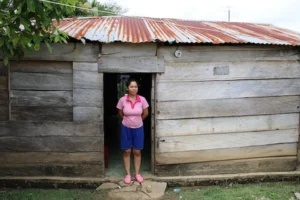
Jairo Vergara (picture on the left) takes a walk through Villa Esperanza in Puerto Libertador. For property issues, a Municipal Land Office can play a role in strengthening the link between the families of San Juan and the government.
Underneath all the problems facing Puerto Libertador’s population, property issues aggravate the confusion. Of the municipality’s nearly 9,000 parcels nearly 70% are not formalized or legalized by the state. This means that the majority of the population does not have any legal guarantees that their land belongs to them. It also means that the municipal administration cannot collect property taxes to invest in improving infrastructure and services. The inability to access new land and to formalize the land they have occupied for decades is a cycle powered by fear and displacement.
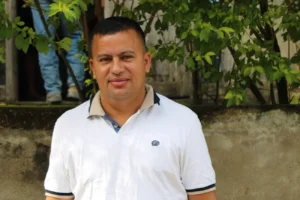
Convincing the Council
In Puerto Libertador, where just three out of 10 landowners have a land title, the municipal council is trying to play a stronger role in land administration. The USAID-funded Land for Prosperity Activity is supporting Puerto Libertador with the creation of a Municipal Land Office where a social worker, topographer, and law expert lead the way to formalize urban properties. Before the office’s official launch in November, USAID worked hand-in-hand to build the municipality’s capacity and develop the ordinance that allows the mayor to formalize urban parcels, including those that are located in peri-urban areas like Villa Esperanza.
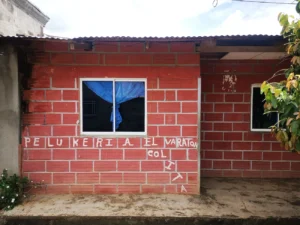 USAID provided the mayor and his council with expertise and consulting to get the ordinance across the finish line. As part of the negotiation, the council agreed that newly formalized landowners would be exempt from taxes in 2022 and will only begin paying property taxes in 2023.
USAID provided the mayor and his council with expertise and consulting to get the ordinance across the finish line. As part of the negotiation, the council agreed that newly formalized landowners would be exempt from taxes in 2022 and will only begin paying property taxes in 2023.
“The lack of formality in our municipality generates chaos. People buy and sell land and never formalize it,” explains Leonardo Callejas, the municipal council’s current president. “Due to the chaos, there is a culture of no-payment of taxes among our population.”
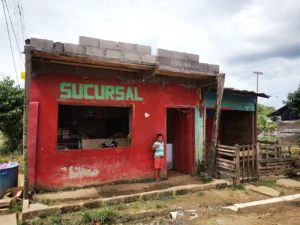 The Story of Tax Collection
The Story of Tax Collection
In Colombia, rural municipalities like Puerto Libertador depend on regalías, or the payments made by mining and energy companies to the government, for investments in development. The money is distributed for items like education, health, and infrastructure according to the municipality’s category and needs. The amount of regalías funds disbursed often comes down to the ability of the municipality to mobilize resources.
For example, municipalities that cannot prove rural schools are formalized or show an inventory of its tertiary roads, cannot receive national funding for those items. As such, property taxes, which are levied and collected by the mayor, can provide rural leaders with a critical boost and a way to make investments that improve the quality of life for the general population.
In Ovejas, a rural municipality in the department of Sucre, the former mayor saw property taxes increase significantly in the years following the creation of the local land office. In addition to giving citizens a physical place to go for matters pertaining to property, saving them money and time, the municipal land office grew the municipality’s tax base. In a three year period, Ovejas saw tax revenue increase from 46 million pesos (USD $15,000) in 2016 to 155 million pesos (USD $50,000) in 2018.
“Ovejas invested a considerable amount of money in formalizing urban properties. I would like to say it again, so everybody knows, because these investments aren’t always visible, when compared with investing in cement,” the former mayor, Mauricio García, said back in 2018.
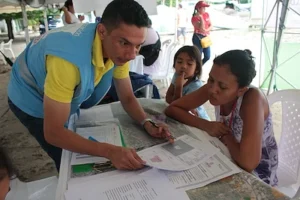
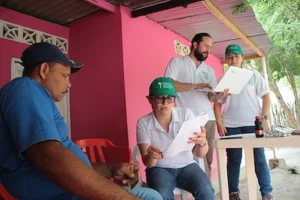
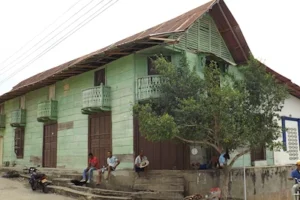
In a three-year period, Ovejas saw tax revenue increase from 46 million pesos (USD $15,000) in 2016 to 155 million pesos (USD $50,000) in 2018.
In Chaparral, a highly populated municipality located in southern Tolima, the current mayor, Hugo Arce, describes the updating and legalization of municipal properties as a “political suicide mission, because people feel like we are putting our hands into their wallets,” he said. “But we did it anyway.”
The strategy seems to have paid off. Arce, who was also mayor between 2012-15, says property taxes increased by 300% over ten years, from 800 million pesos to 3,000 million pesos each year.
“And this has helped us acquire machinery for road work during the rainy season. We had to take the risk and think about the municipality and not just ourselves.”
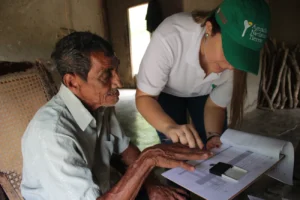 Foundational Diagnostics
Foundational Diagnostics
 The Municipal Land Office’s first task is carrying out a diagnostic of Puerto Libertador’s existing properties. The analysis has revealed that at least 3,600 parcels are able to be formalized by the office, including 240 public parcels that should be formalized in the name of the municipality, such as schools, health clinics, municipal parks, and city buildings.
The Municipal Land Office’s first task is carrying out a diagnostic of Puerto Libertador’s existing properties. The analysis has revealed that at least 3,600 parcels are able to be formalized by the office, including 240 public parcels that should be formalized in the name of the municipality, such as schools, health clinics, municipal parks, and city buildings.
In 2022, the Municipal Land Office is targeting 700 properties. Fabian López, the office’s legal specialist, is working with the team to identify the parcels. Each week, the team is approaching communities like Villa Esperanza to raise awareness about land formalization and the benefits and responsibilities of property ownership.
“In the field, all of our activities consist of showing the population that the work of the land office is directly associated with the municipality and linked to a differential approach for women-headed households,” explains López. “Before we start working in the field, it is important to strengthen local institutions.”
Cross posted from Land for Prosperity Exposure site

